-
Sunlight-activated nanogrid breaks down pollutants in water
Oil spills do untold damage to the environment — to the waters they pollute and to marine and other wildlife. The Deepwater Horizon spill in the Gulf of Mexico in 2010, for example, the largest accidental marine oil spill in the history of the petroleum industry, flowed unabated for three months. Typically, such oil spills are extraordinarily difficult to clean up. Soon, however, the process may become infinitely easier and ecologically friendly, the result of a new invention — “nanogrid” — a large net consisting of metal grids made of a copper tungsten oxide, that, when activated by sunlight, can break down oil from a spill, leaving only biodegradable compounds behind.
-
-
Chelyabinsk meteor explosion a "wake-up call," scientists warn
Three new studies have revealed details of the meteor that exploded above Russian city, Chelyabinsk, in February this year. Their findings provide information about the meteor’s origin, trajectory, power and damage by the airburst (the shock wave that travelled through the air from the explosion). These findings may help to refine theoretical models about the likely frequency of such events, the potential damage they could cause and hazard mitigation strategies needed for planetary protection.
-
-
Wildfire science returns to California’s Rim Fire
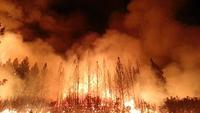
The challenging job of managing wildfires rests with other agencies, but the U.S. Geological Survey (USGS) provides the underlying science for sound land management decisions, before, during, and after wildfires. The USGS role studying natural hazards such as floods, landslides, earthquakes, and volcanoes is well known, but fewer people are aware of the USGS scientific work in major wildfire events, which are one of the most regular and sometimes most devastating natural hazards in the West.
-
-
Safe long-term CO2 storage possible

Since 2004, the German Research Centre for Geosciences (GFZ) has led an international research network to investigate the geological storage of the greenhouse gas (CCS, for carbon capture and storage). GFZ’s scientists say that their work at the Ketzin site, 40 km west of Berlin, has shown that geological CO2 storage on a pilot scale can be done safely and reliably.
-
-
Scientists: we should prepare for hell and high water

An international team of climate and social scientists say a new approach to climate preparedness is essential to help people adjust to coming changes. As climate-driven changes get more pronounced, people everywhere will have to adjust. In this week’s issue of the journal Science, an international group of researchers urge the development of science needed to manage climate risks and capitalize on unexpected opportunities.
-
-
Reducing volume of nuclear waste by 90 percent possible
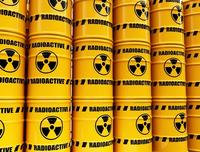
Engineers have developed a way significantly to reduce the volume of some higher activity wastes, which will reduce the cost of interim storage and final disposal. The researchers have shown that mixing plutonium-contaminated waste with blast furnace slag and turning it into glass reduces its volume by 85-95 percent. It also effectively locks in the radioactive plutonium, creating a stable end product.
-
-
Water shortage hobbles expansion of shale gas drilling
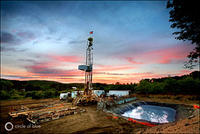
Many point to the large reserves of shale gas as promising U.S. energy independence in the near future. Extracting shale gas, however, requires huge amounts of water, and growing water shortages have already led to conflicts over water use between shale gas developers and farmers. Such conflicts are only going to intensify.
-
-
Leading climate scientists urge support for nuclear power
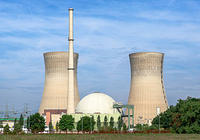
Four of the world’s leading climate scientists have urged environmentalists to support the continuing development of nuclear power as one of the ways to reduce fossil fuel pollution, saying wind and solar energy will not be enough to head off dangerous acceleration of global warming. This is an important point because environmentalists agree that global warming is a threat to ecosystems and humans, but many of the same environmentalists oppose nuclear power, arguing that new forms of renewable energy will be sufficient to meet the world’s need for power within the next few decades.
-
-
Planet’s arable land rapidly degrading

Great civilizations have fallen because they failed to prevent the degradation of the soils on which they were founded. The modern world could suffer the same fate. A new study describes how the productivity of many lands has been dramatically reduced as a result of soil erosion, accumulation of salinity, and nutrient depletion.
-
-
Resources on disaster preparedness, resilience
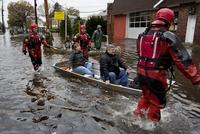
One year after Superstorm Sandy hit the eastern United States, local, state, and federal agencies as well as community groups and businesses are working to strengthen the U.S.s resilience to future disasters. A National Research Council (NRC) has issues a series of studies and reports, and has put together workshops and study groups, which should advance the national conversation on preparedness and resilience.
-
-
Rising temperatures threaten Salt Lake City’s water supply
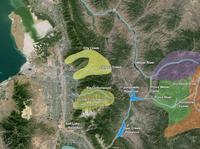
In an example of the challenges water-strapped Western cities will face in a warming world, new research shows that every degree Fahrenheit of warming in the Salt Lake City region could mean a 1.8 to 6.5 percent drop in the annual flow of streams that provide water to the city. By midcentury, warming Western temperatures may mean that some of the creeks and streams that help slake Salt Lake City’s thirst will dry up several weeks earlier in the summer and fall.
-
-
2012 sees slowdown in the increase in global CO2 emissions
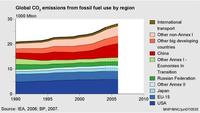
Actual global emissions of carbon dioxide (CO2) reached a new record of 34.5 billion tons in 2012. Yet, the increase in global CO2 emissions in that year slowed down to 1.1 percent, which was less than half the average annual increase of 2.9 percent over the last decade. This is remarkable, as the global economy grew by 3.5 percent. This development signals a shift toward less fossil-fuel-intensive activities, more use of renewable energy, and increased energy saving. Increases in fossil-fuel consumption in 2012 were 2.2 percent for natural gas, 0.9 percent for oil products, and 0.6 percent for coal.
-
-
Improving earthquake early warning systems
Earthquake early warning systems may provide the public with crucial seconds to prepare for severe shaking. For California, a new study suggests upgrading current technology and relocating some seismic stations would improve the warning time, particularly in areas poorly served by the existing network — south of San Francisco Bay Area to north Los Angeles and north of the San Francisco Bay Area.
-
-
Warming will disturb nutrients balance in drylands, affecting food production
Drylands cover about 41 percent of Earth’s land surface and support more than 38 percent of the world’s population. As the world’s population grows, people will increasingly rely on marginal lands — particularly drylands — for production of food, wood and biofuels. Trouble is, an increase in aridity due to global warming will disturb the balance of nutrients in the soil and reduce productivity of the world’s drylands, a landmark study predicts. Increasing aridity is associated with a reduction in carbon and nitrogen in the soil and an increase in phosphorus.
-
-
Where should U.S. radioactive waste be buried?
In the United States, about 70,000 metric tons of spent commercial nuclear fuel are located at more than seventy sites in thirty-five states. Shales and other clay-rich (argillaceous) rocks have never been seriously considered for holding America’s spent nuclear fuel, but it is different overseas. France, Switzerland, and Belgium are planning to put waste in tunnels mined out of shale formations, and Canada, Japan, and the United Kingdom are evaluating the idea.
-
- All
- Regional
- Water
- Biometrics
- Borders/Immig
- Business
- Cybersecurity
- Detection
- Disasters
- Government
- Infrastructure
- International
- Public health
- Public Safety
- Communication interoperabillity
- Emergency services
- Emergency medical services
- Fire
- First response
- IEDs
- Law Enforcement
- Law Enforcement Technology
- Military technology
- Nonlethal weapons
- Nuclear weapons
- Personal protection equipment
- Police
- Notification /alert systems
- Situational awareness
- Weapons systems
- Sci-Tech
- Sector Reports
- Surveillance
- Transportation
Advertising & Marketing: advertise@newswirepubs.com
Editorial: editor@newswirepubs.com
General: info@newswirepubs.com
2010-2011 © News Wire Publications, LLC News Wire Publications, LLC
220 Old Country Road | Suite 200 | Mineola | New York | 11501
Permissions and Policies
Editorial: editor@newswirepubs.com
General: info@newswirepubs.com
2010-2011 © News Wire Publications, LLC News Wire Publications, LLC
220 Old Country Road | Suite 200 | Mineola | New York | 11501
Permissions and Policies
